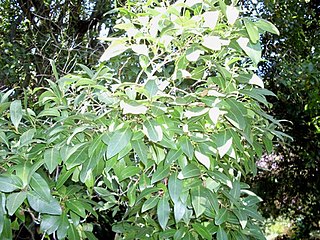
Beilschmiedia elliptica, known as the grey walnut is a rainforest laurel growing in eastern Australia. The range of natural distribution is from Forster, New South Wales to Fraser Island in southeastern Queensland. Beilschmiedia elliptica grows in warm temperate and subtropical rainforests. Not a rare species, but seldom identified in the rainforest.

Stenocarpus salignus, known as the scrub beefwood is an Australian rainforest tree in the family Proteaceae. Found in warmer rainforests on the coast and ranges. It is often found in warm temperate rainforest on poorer sedimentary soils, or on volcanic soils above 750 metres above sea level. It was originally described by the botanist Robert Brown in 1810.

Brachychiton discolor is a rainforest tree of eastern Australia. It grows in drier rainforest areas. Scattered from Paterson, New South Wales to Mackay, Queensland. There is also an isolated community of these trees at Cape York Peninsula.
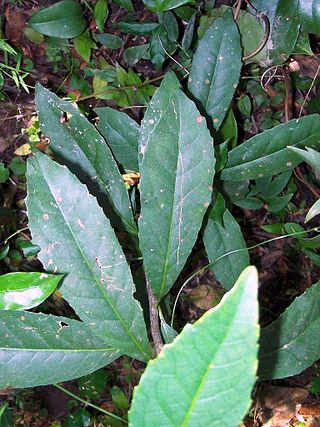
Symplocos thwaitesii, or the buff hazelwood, is a rainforest tree growing in eastern Australia. Seen in tropical, sub-tropical and warm temperate rainforests, often in gullies. Occasionally it grows in cooler situations such as at Monga National Park.

Claoxylon australe, known as brittlewood is a common rainforest shrub or understorey tree. Its habitat includes all types of eastern Australian rainforests. The natural range of distribution is from Eden in southeastern New South Wales to Bowen in tropical Queensland.

Croton verreauxii, known as the green native cascarilla, is a small tree or shrub growing in dry rainforest and rainforest margins in eastern Australia.

Psychotria loniceroides, the hairy psychotria, is a plant native to the forest areas of eastern Australia.

Polyscias sambucifolia, commonly known as elderberry panax or small basswood, is a species of plant native to eastern Australia.

Notelaea venosa is a very common shrub or small tree in eastern Australia. Occurring in or adjacent to rainforest from Lakes Entrance, Victoria to Cunninghams Gap in south eastern Queensland. Common names include veined mock-olive, smooth mock-olive, large-leaved mock-olive and large mock-olive. Often seen in the bushland areas in Sydney.

Elattostachys nervosa, known as the green tamarind or beetroot tree is a common rainforest tree of eastern Australia. Found in all types of rainforest, growing from Paterson, New South Wales in the south to Gympie in south east Queensland. The name Elattostachys refers to "little spikes", a flower feature of other plants in this genus. Nervosa refers to the prominent leaf venation. Beetroot Tree refers to the beetroot red leaves of the new growth.

Mallotus philippensis is a plant in the spurge family. It is known as the kamala tree or red kamala or kumkum tree, due to the fruit covering, which produces a red dye. However, it must be distinguished from kamala meaning "lotus" in many Indian languages, an unrelated plant, flower, and sometimes metonymic spiritual or artistic concept. Mallotus philippensis has many other local names. This kamala often appears in rainforest margins. Or in disturbed areas free from fire, in moderate to high rainfall areas.

Drypetes deplanchei is a tree of eastern and northern Australia. It also occurs in New Caledonia and Lord Howe Island. The genus is derived from the Greek, dryppa meaning "olive fruit". The species named after Dr. Emile Deplanche, who collected this plant at New Caledonia. Common names include yellow tulip, grey boxwood, white myrtle, grey bark and yellow tulipwood.
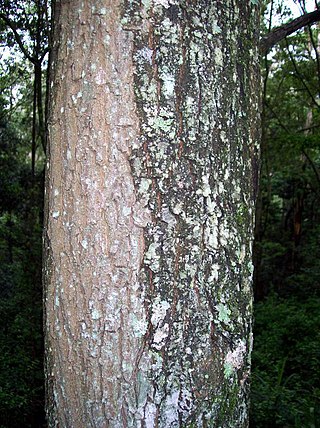
Bridelia exaltata, known as the brush ironbark or scrub ironbark, is a tree of eastern Australia. It occurs in and on the margins of the drier rainforests, and also by streams, often in association with the black bean, up to an elevation of 600 metres above sea level. It occurs from Seal Rocks, New South Wales to Maryborough, Queensland.
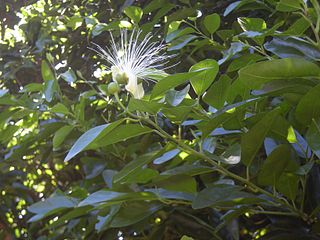
Capparis arborea is a bush or small tree occurring in eastern Australia. Its habitat is rainforest, usually riverine, littoral or the drier rainforests. It is distributed from the Hunter River, New South Wales to Cape Melville in tropical Queensland. Common names include native pomegranate, wild lime, wild lemon and brush caper berry. Capparis arborea is a host plant for the caper white , which migrate across the eastern seaboard in large numbers in the summer. It also feeds the chalky white

Rhodamnia argentea is a rainforest tree of eastern Australia. Commonly known asmalletwood, white myrtle, silver leaf, silver malletwood and white turpentine. The natural habitat is a variety of different rain forests, at sea level or in the adjacent ranges. Growing on sand, alluvium and volcanic based soils. From the Hastings River, New South Wales to Bowen, Queensland.
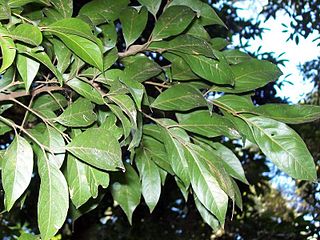
Sarcopteryx stipata, known as the steelwood, is a rainforest tree of eastern Australia occurring from the Bulga Plateau and Comboyne Plateau north west of Taree, New South Wales as far north as Fraser Island off the coast of south eastern Queensland. It grows in sub tropical rainforest but sometimes occurs in warm temperate rainforests on poorer soils. It is a member of the soap berry family. The generic name Sarcopteryx translates to "fleshy wing", as the fruit can be wing shaped. Stipata means "surrounded". The common name steelwood refers to the very tough, hard and heavy timber.

Alangium polyosmoides is a rainforest tree of eastern Australia. It occurs on a variety of different soils, generally close to the coast. Found from Minmi near Newcastle to as far north as the McIlwraith Range in far northeastern Queensland. It may be seen as a common understorey plant at Wingham Brush Nature Reserve.

Mallotus claoxyloides is an Australian rainforest plant in the spurge family. Common names include green kamala, odour bush, and smell of the bush. Opinions are divided on the strong scent of the plant. Some say it is offensive and resembles a skunk while most others find the scent aromatic and delightful. Because of the scent, it is grown in gardens.
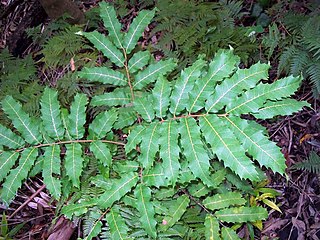
Cupaniopsis newmanii is a rainforest plant in the soapberry family. It is native to eastern Australia. The common name is long-leaved tuckeroo. A rare plant, with a ROTAP listing of 2RC-. The habitat is subtropical rainforest ranging from Mullumbimby in New South Wales to Gympie in south-eastern Queensland.

Petalostigma triloculare, known as the long-leaved bitter bark is a rainforest tree of eastern Australia. It occurs in the drier rainforests, often on sandy soil derived from granite or sandstone, and is sometimes seen on old sand dunes.





















